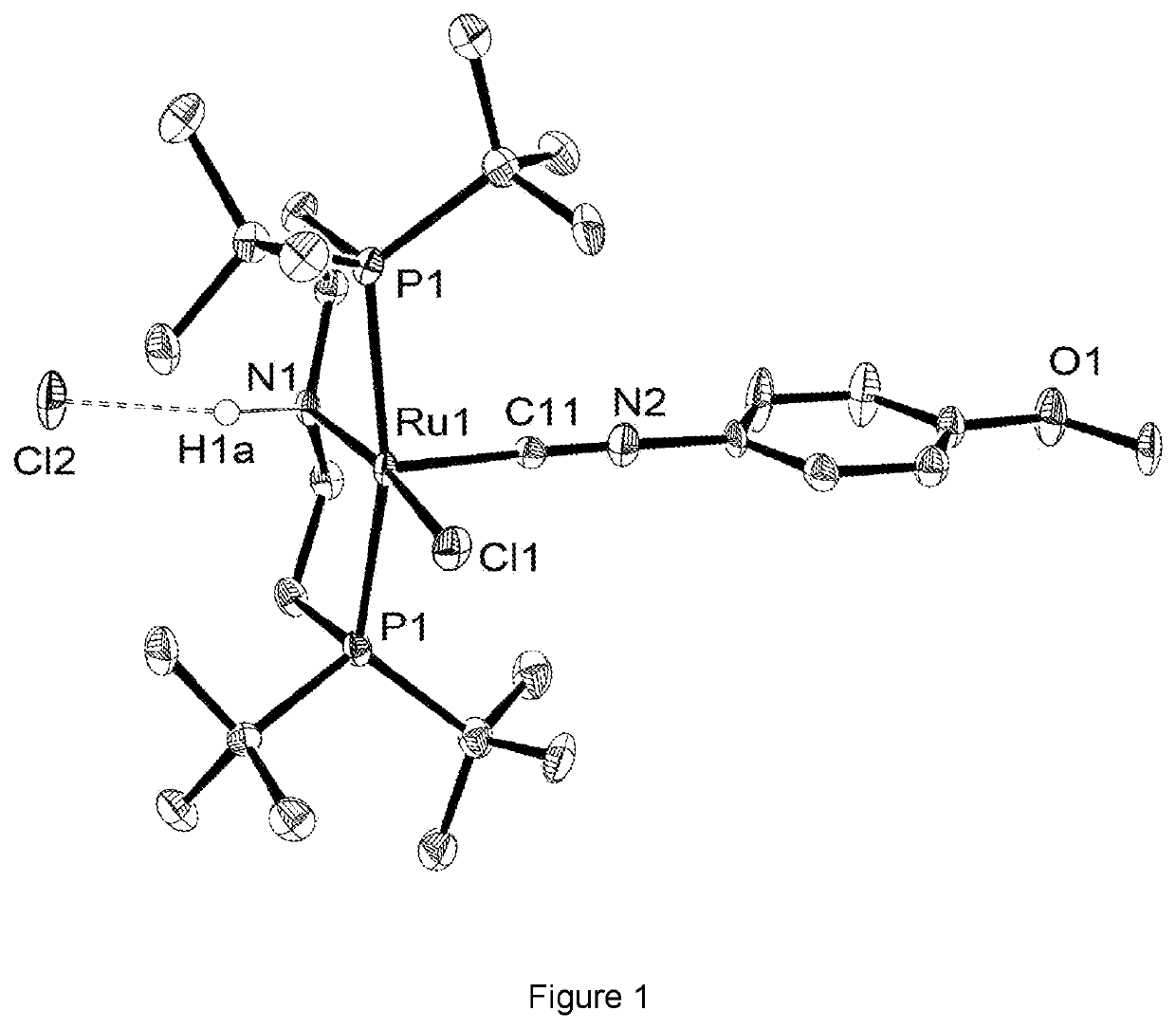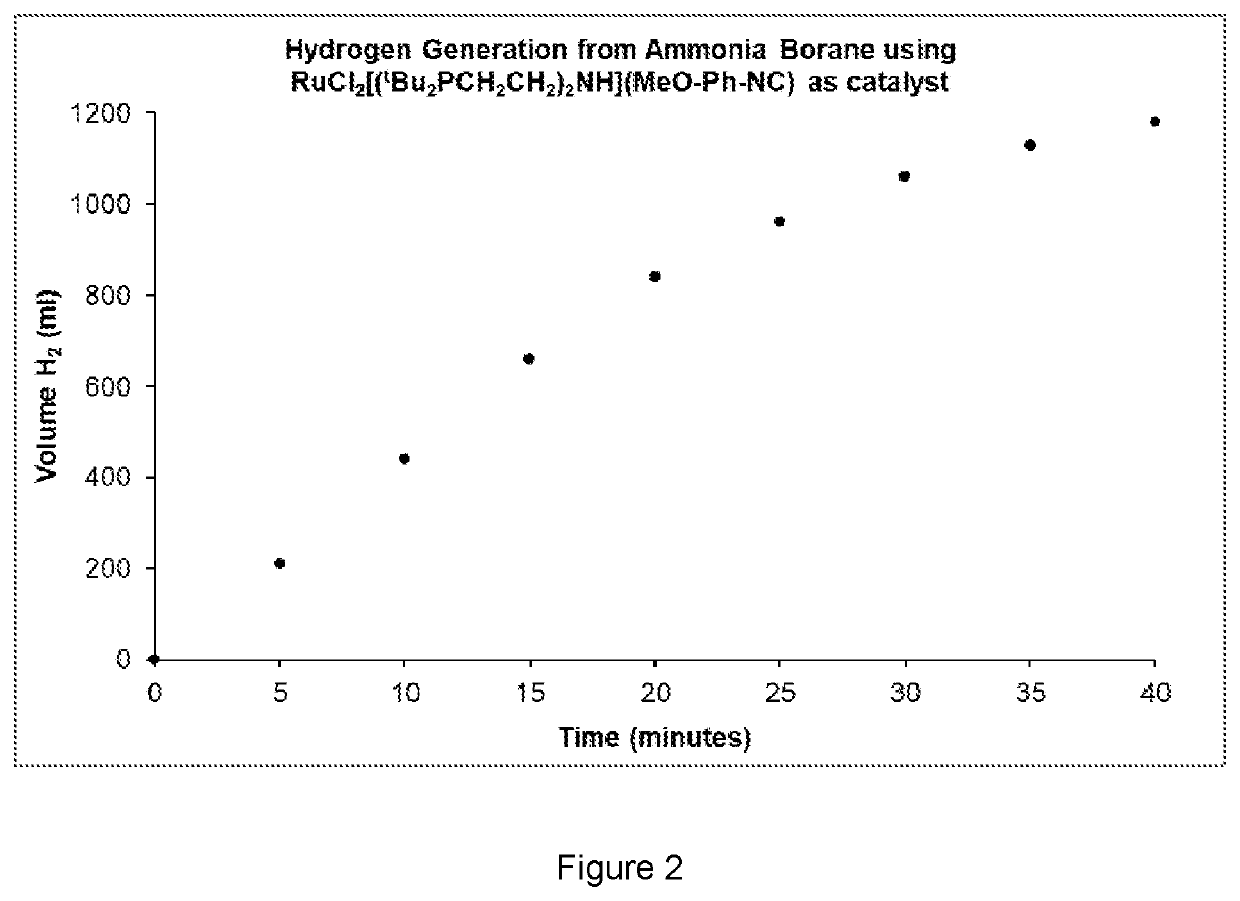Transition metal isonitrile catalysts
a technology of metal isonitrile and catalyst, which is applied in the preparation of organic compounds, organic compounds/hydrides/coordination complexes catalysts, and amino-hyroxy compounds, etc. it can solve the problems of not being readily substituted by other ligands, and achieve enhanced activity of metal catalysts, reduce steric congestion, and facilitate hydrogenation. high
- Summary
- Abstract
- Description
- Claims
- Application Information
AI Technical Summary
Benefits of technology
Problems solved by technology
Method used
Image
Examples
example 34
ion of Benzylidene Acetone Using Ruthenium Isonitrile Compounds as Catalysts
[0108]
Example 35.1. Hydrogenation of Benzylidene Acetone Using RuCl2[(Ph2PCH2CH2)2NH](t-Bu-NC) as Catalyst
[0109]The catalyst (5 mg) is added to a mixture of benzylidene acetone (2.0 g), 2-propanol (10 ml) and KOtBu (10 mg) in a 100 ml Parr pressure reactor. The mixture was degassed with hydrogen and the pressure was set to 10 atm. The mixture was stirred for 5 hours at room temperature. The solvent was then removed under reduced pressure. The NMR spectra of the reaction mixture showed complete conversion of the ketone to the alcohol.
Example 35.2. Hydrogenation of Benzylidene Acetone Using RuCl2[(iPr2PCH2CH2)2NH](t-Bu-NC) as Catalyst
[0110]The catalyst (5 mg) is added to a mixture of benzylidene acetone (2.0 g), 2-propanol (10 ml) and KOtBu (10 mg) in a 100 ml Parr pressure reactor. The mixture was degassed with hydrogen and the pressure was set to 10 atm. The mixture was stirred for 5 hours at room temperatur...
example 36
ion of N-(Benzylidene)phenylamine Using Ruthenium Isonitrile Compounds as Catalysts
[0112]
Example 36.1. Hydrogenation of N-(Benzylidene)phenylamine Using RuCl2[(Ph2PCH2CH2)2NH](t-Bu-NC) as Catalyst
[0113]The catalyst (10 mg) is added to a mixture of N-(Benzylidene)phenylamine (1.0 g), toluene (2 ml) and KOtBu (10 mg) in a 100 ml Parr pressure reactor. The mixture was degassed with hydrogen and the pressure was set to 10 atm. The mixture was stirred for 12 hours at 50° C. The solvent was then removed under reduced pressure. The NMR spectra of the reaction mixture showed complete conversion of the imine to the amine.
Example 36.2. Hydrogenation of N-(Benzylidene)phenylamine Using RuCl2[(iPr2PCH2CH2)2NH](t-Bu-NC) as Catalyst
[0114]The catalyst (10 mg) is added to a mixture of N-(Benzylidene)phenylamine (1.0 g), toluene (2 ml) and KOtBu (10 mg) in a 100 ml Parr pressure reactor. The mixture was degassed with hydrogen and the pressure was set to 10 atm. The mixture was stirred for 12 hours a...
example 37
ion of Methyl Benzoate Using Ruthenium Isonitrile Compounds as Catalysts
[0116]
Example 37.1. Hydrogenation of Methyl Benzoate Using RuCl2[(Ph2PCH2CH2)2NH](t-Bu-NC) as Catalyst
[0117]The catalyst (10 mg) is added to a mixture of methyl benzoate (200 mg), toluene (1.0 ml) and KOtBu (10 mg) in a 100 ml Parr pressure reactor. The mixture was degassed with hydrogen and the pressure was set to 20 atm. The mixture was stirred for 12 hours at 100° C. It was then cooled to room temperature. The NMR spectra of the reaction mixture showed 80% conversion of the ester to the alcohol.
Example 37.2. Hydrogenation of Methyl Benzoate Using RuCl2[(iPr2PCH2CH2)2NH](t-Bu-NC) as Catalyst
[0118]The catalyst (10 mg) is added to a mixture of methyl benzoate (200 mg), toluene (1.0 ml) and KOtBu (10 mg) in a 100 ml Parr pressure reactor. The mixture was degassed with hydrogen and the pressure was set to 20 atm. The mixture was stirred for 12 hours at 100° C. It was then cooled to room temperature. The NMR spectr...
PUM
| Property | Measurement | Unit |
|---|---|---|
| length | aaaaa | aaaaa |
| chemical reaction | aaaaa | aaaaa |
Abstract
Description
Claims
Application Information
 Login to View More
Login to View More - R&D
- Intellectual Property
- Life Sciences
- Materials
- Tech Scout
- Unparalleled Data Quality
- Higher Quality Content
- 60% Fewer Hallucinations
Browse by: Latest US Patents, China's latest patents, Technical Efficacy Thesaurus, Application Domain, Technology Topic, Popular Technical Reports.
© 2025 PatSnap. All rights reserved.Legal|Privacy policy|Modern Slavery Act Transparency Statement|Sitemap|About US| Contact US: help@patsnap.com



